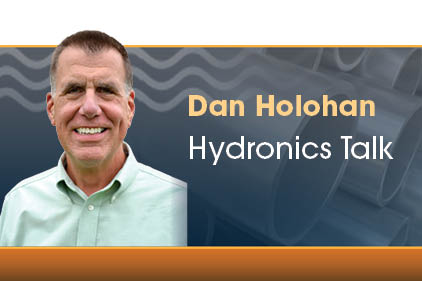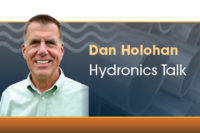World Travelers
These 10 themes are worth keeping an eye on.


|
|
The showroom floor from ISH Frankfurt 2011. The 2013 event was March 12-16. Photo courtesy of Messe Frankfurt Exhibition GmbH/Petra Welzel. |
I love the odd-numbered years because they contain ISH Frankfurt. This year was my 12th consecutive visit to that enormous hydronic feast. Which is not to say ISH is only about hydronics.
More and more, the show embraces other emerging technologies, and hydronics is becoming less about boilers and more about controlling water and the heat it transports from here to there.
As always with ISH, the folks in charge establish themes beforehand, which is a fine way to focus our attention. They see these themes as being very important to the world in the present time, and these themes have changed since 1991 when I first attended.
Will these themes make the jump across the ocean and play a part in the U.S. market? Time will tell but based on what I’ve watch happen over the years, I’d say yes to a lot of it. The world is getting smaller and this ain’t your grandpa’s boiler room.
Here’s where the focus is right now.
Efficient heating systems for gas and oil: In Europe, it’s all about condensing appliances, which many countries now require. Customers understand these highly efficient appliances will last only about 10 years, which seems crazy to most Americans but Europeans have come to accept that fact of life. ISH pairs the condensing appliances with low-temperature heating systems and it also combines them with efficient heat pumps and solar thermal for heating domestic hot water. The controls that make all this happen just keep getting smarter.
Systems that collect ambient and geothermal heat: There’s nothing more renewable than the warmth of the sun, and this theme is about using two types of heat pumps. The first takes heat from the air and moves it into water. The second uses a mixture of brine and water, pumped about 100 yards into the earth to pick up geothermal heat, which then transfers its heat to an evaporative coolant. Here, too, they recommend the use of low-temperature systems (think lots of radiant systems). Compared to the U.S., heat pumps are relatively new news to the Europeans, so we might think of this as a reverse theme, one that’s jumping the ocean the opposite way, which is nice.
Heating systems utilizing wood: Using wood doesn’t bring additional carbon to the surface of the earth so that makes it a green fuel. At ISH, they show 90 percent-efficient appliances that burn wood pellets, logs or woodchips. The U.S. is currently the world’s largest exporter of wood pellets and lately these energy-packed nuggets have been making news because they release a lot of carbon monoxide as they sit there in large piles. People have died by entering areas where wood pellets have just been laying around in storage, and that’s something we need to keep in mind as this technology spreads. Hey, who knew?
Thermal systems for solar energy use: Collect the heat from the sun with a fluid that won’t freeze and use a heat exchanger to transfer that heat into a tank filled with water. Then use the water in that tank to heat the house or the domestic hot water. Again, the focus is on low-temperature heating systems, and they figure this sort of thermal storage can take care of up to 60% of the needs. It’s not new news but it’s a big theme at ISH and well worth watching.
Electricity-generating heating systems: These showed up in a big way about 10 years ago at ISH. They call them mini- or micro-CHPs. CHP is an acronym for combined heat and power. Some of these units hang on the wall like a condensing boiler and can produce up to 20 kWh of power and about 15,000 Btu/hr., for the radiators at the same time. Most use an internal-combustion engine that runs on natural gas. The engine runs a generator and the engine coolant moves the heat into the heating system. It works sort of like the heater in your car, only it’s hydronic. The big question I have, though, is whose trade is this? Is it the heating contractor’s or the electrician’s? Or will we be seeing a new sort of boutique contractor who specializes in these? All I can say is stay tuned.
Large-scale combustion systems and process heat: Here, ISH is focusing solely on Europe. The goal is to get more-efficient burners and heat-recovery systems into the large European industrial plants so countries can meet the mandated requirements to lower carbon emissions by a certain date. They figure 80% of the plants are more than 10 years old, and those are the plants they’re targeting. I think about this whenever I’m on the northern section of the New Jersey Turnpike watching all that energy from all those plants spew into the sky. Anyone but the drivers looking at that?
Energy-efficient ventilation and air-conditioning technology: I read an article in an American newspaper about how our buildings are becoming sources of sickness as we tighten them up without giving much thought to what this is doing to the quality of the indoor air. At ISH, they’ve adopted this theme in the interest of health as well as fuel efficiency. In much of Europe, they now have a certification system that looks at the airflow velocity within the device, the electrical power consumption of the fan and the quality of the heat recovery system. They say energy efficiency and comfort are no longer a contradiction in terms. That’s nice and you know what else will be nice? The business fixing lousy indoor air will bring you in the days ahead.
Energy-efficient room air conditioners and heat pumps: When I first started traveling in Europe, the idea of air conditioning involved opening the window and letting the wind do the rest. Since then, a lot of inefficient window units and split systems have appeared over there. Within the European Union, they fix this by issuing directives that demand higher efficiency, which equipment manufacturers must then follow. Compare that procedure to what we have in America. You sweaty? Just drive over to Wal-Mart and get yourself one of those 80-buck window shakers from China.
Energy efficiency and comfort in residential buildings: Speaking of directives, the Germans have rules for tightening up houses that are stricter than Sister Magdala’s Catechism class. Because of this, there’s serious need for ventilation and consequently heat recovery. ISH presents a smorgasbord of solutions to this challenge. If you can’t breathe and there’s mold growing, you can’t be comfortable. The solution to one problem often causes another problem. There’s business in both.
High-end ventilation and air-conditioning technology: They’re focusing now on cooling systems that don’t use coolants. Instead, you’ll see intelligent heat recovery in the winter and evaporative cooling during the summer. They say these systems use almost no heat energy for the supply air and reduce the cooling energy needed for conditioning outdoor air by about 50%.
They also use absorption systems to dehumidify the outdoor air, making this process separate from the cooling process. That means they don’t have to cool water to a very low temperature for dehumidification. Think ground water from a geothermal source. Oh, and also think solar collectors or the waste heat from a combined heat-and-power unit for dehumidification. As the pig farmer says, “We use everything but the Oink!”
And as the folks at ISH say, think high-end.
HELPFUL LINKS:
Looking for a reprint of this article?
From high-res PDFs to custom plaques, order your copy today!






